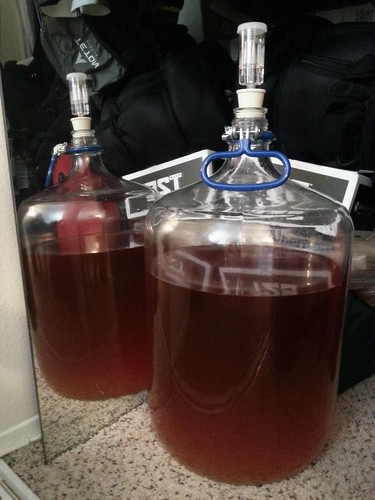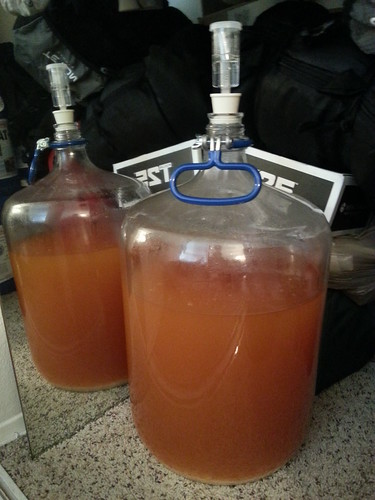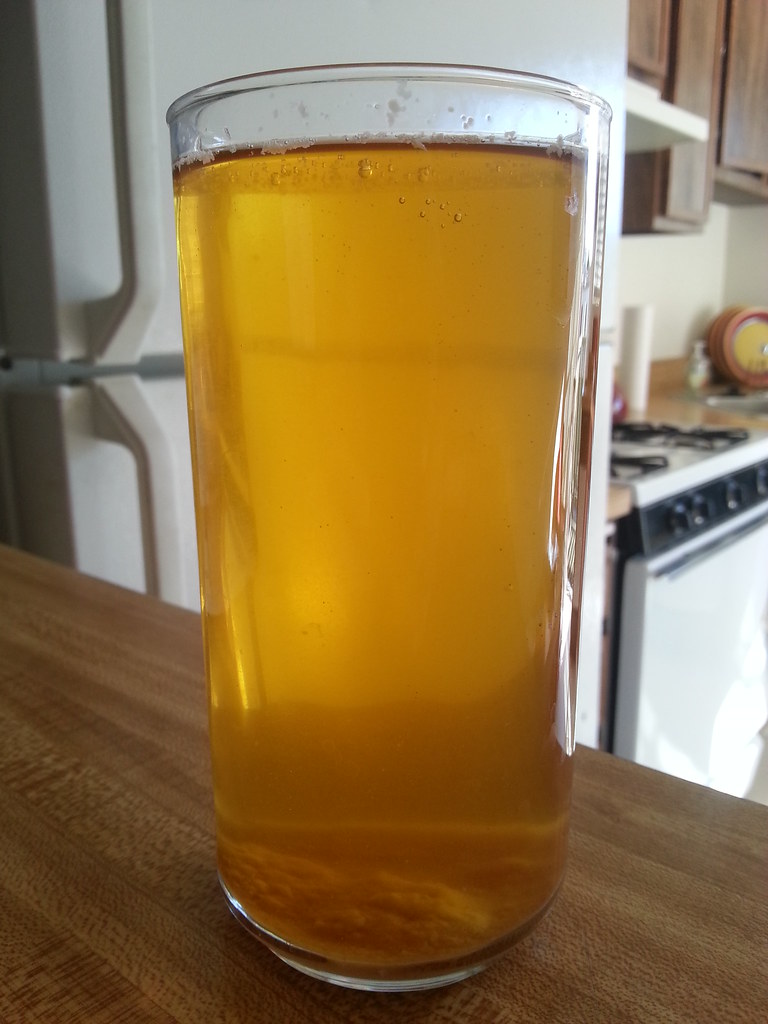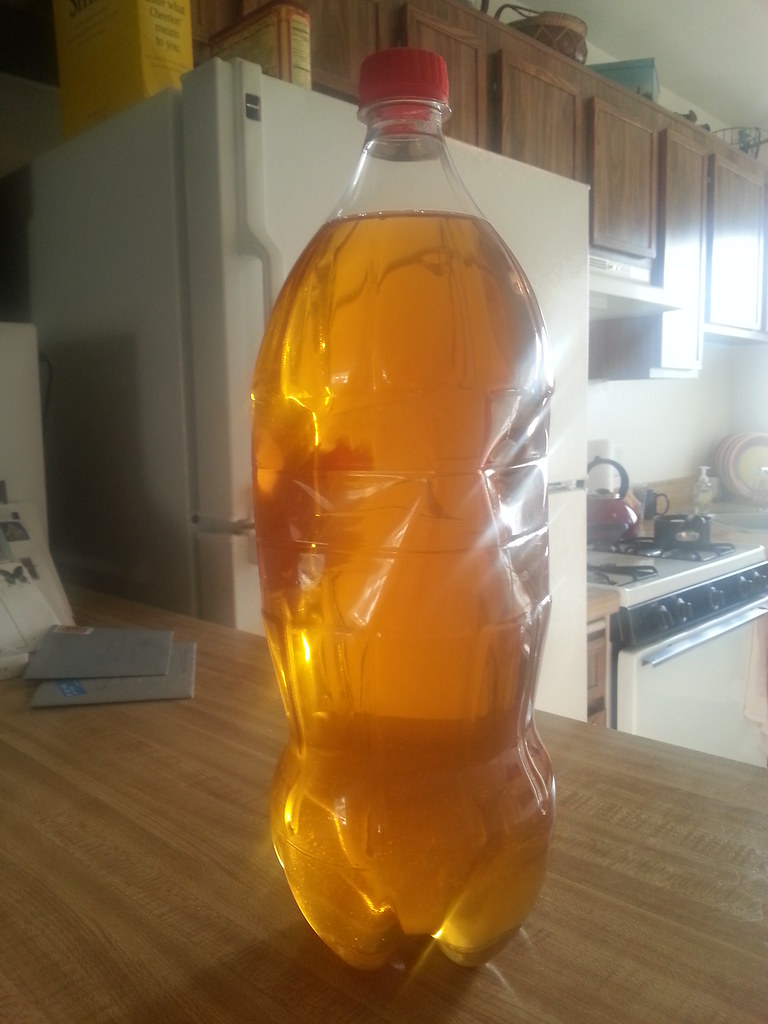Over the holidays I enjoyed some sparkling cider provided by my nephew. Wanting more, I spent some time discussing with him how he made his cider, with the thought of emulating what he did. Now, as I read online what other people do, his method is seeming a little unorthodox.
He claimed to brew 5 gallons of from-concentrate apple juice for a week or so, then bottling it in PET bottles, where the continuing fermentation carbonated the beverage. His fermentation vat was a 5-gallon plastic water bottle with a tube going from the top down into another bottle of water as a makeshift air lock.
Back at home, I found I have an excellent homebrew supplier a mile away (Hydrobrew). I thought I'd drop in and check it out, and drove off with a 6.5 gallon carboy (thinking it would be most versatile), a 3-piece air lock matched with a drilled bung, a packet of Safale S-04 English Ale yeast, and some Iodophor.
A trip to Target garnered 5 gallons of store-brand Market Pantry apple juice from concentrate (with ascorbic acid) in plastic 1-gallon jugs. From Amazon.com I acquired a hydrometer and 12-inch test jar. I sanitized all my new equipment along with a funnel and a turkey baster from the kitchen, and poured the apple juice into the carboy. I measured the SG at 1.050, so with the ambient temperature at 73F I figure it at 1.052. (I figured it was air temperature that mattered, but should I base it on the liquid temperature instead?)
Next I added the yeast, stoppered the carboy with the air lock half-filled with Iodophore, and put it in a closet. That was yesterday, late morning. Today when I got home from work I found my brew was a cloudy orange and the air lock was bubbling at a rate of more than once a second. I'm guessing the temperature in that closet ranges from the mid 60's to the mid 70's.

What I'd like to do, based on discussions with my nephew, is bottle directly from my primary to 2-liter PET bottles once the SG is low enough for continuing fermentation to carb them up. That would be at, what, 1.010 to 1.005 SH? I have to admit I'm not feeling extra patient right now. But I'm having doubts about this based on what I'm reading on this forum.
So what say you all? Is my plan worth trying, given I have potentially years of brewing ahead of me to experiment? Should I get a 5-gallon carboy now and rack to that, and resign myself to the back-sweetening that might imply? Try something else? (I only have about 7 2-liter PET bottles, so will probably still have a gallon or so I can experiment with....)
Also--I'm thinking I need to check the SG before too long, but wondering if there's some trick to getting a sample out of there without contaminating things. To use my turkey baster I have to tip the carboy over part way. Help?
At least I'm having fun already.
Thanks in advance!
He claimed to brew 5 gallons of from-concentrate apple juice for a week or so, then bottling it in PET bottles, where the continuing fermentation carbonated the beverage. His fermentation vat was a 5-gallon plastic water bottle with a tube going from the top down into another bottle of water as a makeshift air lock.
Back at home, I found I have an excellent homebrew supplier a mile away (Hydrobrew). I thought I'd drop in and check it out, and drove off with a 6.5 gallon carboy (thinking it would be most versatile), a 3-piece air lock matched with a drilled bung, a packet of Safale S-04 English Ale yeast, and some Iodophor.
A trip to Target garnered 5 gallons of store-brand Market Pantry apple juice from concentrate (with ascorbic acid) in plastic 1-gallon jugs. From Amazon.com I acquired a hydrometer and 12-inch test jar. I sanitized all my new equipment along with a funnel and a turkey baster from the kitchen, and poured the apple juice into the carboy. I measured the SG at 1.050, so with the ambient temperature at 73F I figure it at 1.052. (I figured it was air temperature that mattered, but should I base it on the liquid temperature instead?)
Next I added the yeast, stoppered the carboy with the air lock half-filled with Iodophore, and put it in a closet. That was yesterday, late morning. Today when I got home from work I found my brew was a cloudy orange and the air lock was bubbling at a rate of more than once a second. I'm guessing the temperature in that closet ranges from the mid 60's to the mid 70's.

What I'd like to do, based on discussions with my nephew, is bottle directly from my primary to 2-liter PET bottles once the SG is low enough for continuing fermentation to carb them up. That would be at, what, 1.010 to 1.005 SH? I have to admit I'm not feeling extra patient right now. But I'm having doubts about this based on what I'm reading on this forum.
So what say you all? Is my plan worth trying, given I have potentially years of brewing ahead of me to experiment? Should I get a 5-gallon carboy now and rack to that, and resign myself to the back-sweetening that might imply? Try something else? (I only have about 7 2-liter PET bottles, so will probably still have a gallon or so I can experiment with....)
Also--I'm thinking I need to check the SG before too long, but wondering if there's some trick to getting a sample out of there without contaminating things. To use my turkey baster I have to tip the carboy over part way. Help?
At least I'm having fun already.
Thanks in advance!





